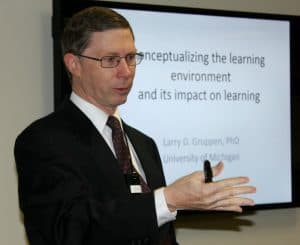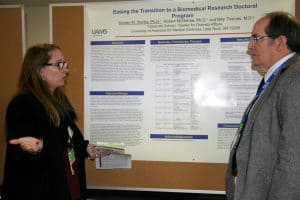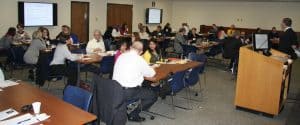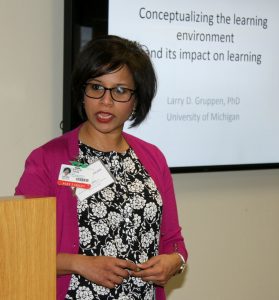Teacher Symposium Gives Educators Practical Tools
| Feb. 27, 2017 | Learning environments are something we take for granted when they are right, but we certainly notice when they are wrong. And they are made up of a lot more than just bricks and mortar.
“A better question might be: What isn’t part of the learning environment?” said Larry Gruppen, Ph.D., a professor in the Department of Learning Health Sciences at the University of Michigan Medical School.
Gruppen led a group of 55 UAMS faculty from across the state in a discussion about learning environments as part of the Teach the Teacher Symposium held Jan. 27 at UAMS. Gruppen is director of the Master in Health Professions Education program and his research centers around educational leadership development. The eighth annual event was sponsored by the UAMS College of Medicine and UAMS Office of Educational Development Educators Academy.
The theme for the symposium was Creating and Sustaining Supportive Learning Environments. Other workshops at the symposium included:
- “Setting the Stage for Clinical Learning,” Sara Tariq, M.D., and Sowmya Patil, M.D.
- “Improving the Learning Environment in Didactic Courses,” James Graham, M.D., and David Davies, Ph.D.
- “Student Perceptions of Mistreatment,” Gruppen.
All of the workshops were interactive, and that was by design, said Tariq, the event’s main organizer. She is assistant dean for undergraduate clinical education in the UAMS College of Medicine and an associate professor in the Department of Internal Medicine.
“This conference was set up to really provide UAMS educators with practical tools to help them be more effective teachers – tools that are simple enough that they can implement them tomorrow,” Tariq said.
Gruppen said learning environments can range from personal-level factors like what past educational experiences the student brings to the table and how much they respect authority, to group-level interactions like how well the students in the class get along with each other and the teacher. Factors like whether the class is online or in person come into play, as does the amount of hands-on work. And the impact of the culture of the school, community and society at large cannot be ignored.

Larry Gruppen, Ph.D., leads participants in the Teach the Teacher Symposium in a discussion on how the learning environment effects student success.
He encouraged the group to think about how the learning environment might be influenced at the different hierarchical levels. He said most of the past research has been focused on student-feedback surveys, which only measure a small part of the hierarchy.
“What we need to do is recognize the limitations of relying just on student questionnaires because that is a limited perspective within that hierarchy, and the problems we’re dealing with need to be addressed from multiple levels. It’s unlikely that simply fixing things at the personal or group level is going to address the challenges that you might confront,” he said.
Jan Shorey, M.D., associate provost for faculty, has made it a point to attend the symposium every year.
“I come for two reasons, my own continued learning as an educator, and secondly, it’s my job to help shepherd our faculty and help them become better educators and have access to faculty development,” Shorey said.
In a new addition, a poster session was included this year. Shorey said it was interesting to see the variety of disciplines represented and the exchange of information between them.
Karina Clemmons, Ed.D., associate professor in the Division of Medical Humanities in the College of Medicine, echoed Shorey’s sentiments. She presented a poster on her research on developing and sustaining supportive learning environments.

Kristen Sterba, Ph.D., left, discusses her research on ‘Easing the Transition to a Biomedical Research Doctoral Program’ with Lawrence Tarbox, Ph.D.
“I think it is really helpful to come together in a setting where we can collaborate on all the educational projects we’re doing,” Clemmons said. “Sometimes, we don’t talk to each other because the campus is so large and you just might not be aware of the work another department is doing. It’s important that we take the time to collaborate on improving education, not just in our own departments, but across campus.”
The following posters were presented by UAMS faculty:
- “Enriching Curriculum Changes to the Fourth Year Medicine Clerkship Course,” Latha Achanta, M.D., M.P.H.
- “Advancing Learning in a Pharmacology Course Through the Use of Standardized Patients in a Simulated Encounter,” Courtney Bookout, Pharm.D. candidate; Bethany Boyle, Pharm.D. candidate; Kristina Erbach, Pharm.D. candidate; Sarah Thornton, Pharm.D. candidate; Nukhet Aykin-Burns, Ph.D.; Lindsey Dayer, Pharm.D.; Ashley N. Castleberry, Pharm.D.
- “Academic Monitoring Strategies to Develop and Sustain Supportive Learning Environments,” Karina R. Clemmons, Ed.D.; Jasna Vuk, M.D., Ph.D.
- “The State of Our Students: Depression, Anxiety and the Self-Care Practices of Undergraduate Pre-Licensure Nursing Students,” Ashley Davis, R.N., M.N.Sc.
- “Utilizing Simulation to Enhance Competency in Tracheostomy and Laryngectomy Management,” Kevin A. Davies, M.D.; Courtney Edgar-Zarate, M.D.; Julianna Bonilla-Velez, M.D.; Timothy N. Atkinson, Ed.D.; Ozlem Tulunay Ugur, M.D.; Amit Agarwal, M.D.
- “Multiple-Mini Interview for Pharmacy Admissions is Prognostic for APPE Scores,” Lindsey Dayer, Pharm.D.; Schwanda Flowers, Pharm.D.; Bradley C. Martin, Pharm.D., Ph.D.; Catherine E. O’Brien, Pharm.D.; Angie N. Choi, Ph.D.; Janna Hawthorne, Pharm.D.; Kelsey Willis, B.S.; Morgan Ramey, Pharm.D.; Seth Heldenbrand, Pharm.D.
-

Participants in the Teach the Teacher Symposium discuss learning environments during a group exercise.
“Faculty Roles in Curriculum Mapping to Improve Learning and Curriculum Effectiveness,” Stanley K. Ellis, Ed.D; Kimberly Morris-Ross, M.Ed.
- “Bedside Assessment Skill Acquisition: Are Students ‘Getting it?’” Dona Friend, R.N., M.N.Sc.; Mark Tanner, R.N.; Hope Meyers, R.N., B.S.N.; Nicole Ward, R.N., A.P.R.N.; Sue Ragsdale, M.S.N., A.P.R.N.; Kathy Flores, M.Ed., B.S.N., R.N.; Karen Bristow, R.N., B.S.N.
- “Increasing Medical Student Interest in Surgery: A Pre-Clinical Surgery Program” Mary K. Kimbrough, M.D.; Carol R. Thrush, Ed.D.; Matthew R. Smeds, M.D.; Frederick R. Bentley, M.D.
- “Maintaining Concentration in the Classroom,” Issam Makhoul, M.D., Frank Simmen, Ph.D., Mathew Deneke, M.D.
- “Interprofessional Education Experience in Department of Geriatrics: A QI Initiative,” Priya Mendiratta, M.D., M.P.H.; Ann T. Riggs, M.D.; Joel B. Goodin, Ph.D.; Paula Podrazik, M.D.
- “Simulated Clinical Encounter Feedback Improves Geriatric Communication and Assessment Skills,” Priya Mendiratta, M.D., M.P.H.; Ann T. Riggs, M.D.; Joel B. Goodin, Ph.D., M.S.; Paula Podrazik, M.D.
- “Growing Our Own in the Delta (GOOD) Scholars Program: A Socio-Rcological Model Approach to Retain Underrepresented Groups in Nursing,” Larronda Rainey, M.N.Sc., R.N.; Kimberly Hayman, B.S.N., R.N., Ph.D. candidate; Keneshia Bryant-Moore, Ph.D.; Alexa Bessette, M.B.A.
- “Easing the Transition to a Biomedical Research Doctoral Program,” Kristen Sterba, Ph.D.; Robert McGehee, Ph.D.; Billy Thomas, M.D.
- “Using Standardized Patients to Enhance Learning in a Pharmacology Course,” Sarah Thornton, Pharm.D. candidate; Kristina Erbach, Pharm.D. candidate; Courtney Bookout, Pharm.D. candidate; Bethany Boyle, Pharm.D. candidate; Ashley N. Castleberry, Pharm.D., M.A.Ed
- “Benefits of the Peer Tutoring Program at UAMS: Perspectives of Peer Tutors and Tutees,” Jasna Vuk, M.D., Ph.D.
- “Collaborative Efforts Between Instructor and Learning Specialist to Monitor Students’ Progress,” Jasna Vuk, M.D., Ph.D., Grazyna Nowak, Ph.D.

